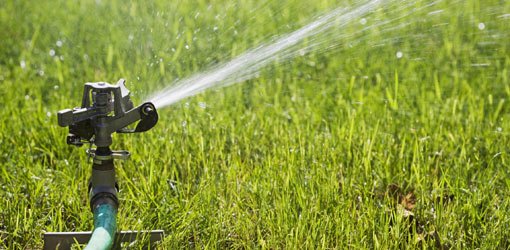How to Calculate Lawn Irrigation Water Usage and Costs

In my years of closely observing outdoor spaces, I’ve noticed a growing problem: maintaining a vibrant lawn while dealing with widespread drought and rising water costs. It’s a challenge that affects both our yards and our wallets. That’s why I’ve put together this guide to help you calculate your lawn’s irrigation needs efficiently.
By the end, you’ll know exactly how much water your lawn needs and what it costs. This will help you keep your grass green without using up valuable resources.
Watering Do’s and Don’ts
Water your yard early in the morning and soak the ground thoroughly so that it penetrates to a depth of at least 3″. While the amount of water needed will vary depending on your climate, the weather, and the time of year; the general rule of thumb is to make sure your lawn receives 1″ of water to your lawn per week during dry conditions.
To see how much water your grass is actually receiving, put several containers with straight sides—such as a coffee mug, metal can, or plastic container—on the ground around the yard while you are watering. Then use a ruler to measure the depth of the water in the container.
Calculating Water Use
To provide your lawn with one inch of water takes a little over half a gallon per square foot (0.623 gallon to be more exact). That means that every 10’x10’ area will require over 62 gallons of water. That doesn’t sound like much until you consider that a 100’ x 100’ lawn uses 6,230 gallons of water every time you turn on the sprinklers!
To figure out how much water you use, add the width and length of your yard in feet to get the number of square feet. Then multiply that figure by 0.623 to come up with the number of gallons used (or use our calculator below).
This assumes that your yard is square or rectangular. For more unusual shapes, you’ll have to dig out your old high school geometry book to come up with the amount of area involved.
Calculating Water Costs
Now that you know how much water you’re using, you can estimate how much it will cost to keep your lawn green. While city water systems usually give separate prices for water and sewer services on your bill, in most cases both are actually based on the number of gallons of water you use.
So for every 1,000 gallons of water that comes out of your faucet, you are also charged not only for the water but for 1,000 gallons of sewerage.
This holds true regardless of whether it goes down the drain or on your grass. Many cities will install a separate meter for irrigation purposes that does not include the cost of sewerage.
To figure out how much it costs to water your yard, divide the number of gallons used by 1,000, then add up the price you pay per 1,000 gallons (see our cost calculator below).

Don’t forget to include the sewer costs unless you have a separate meter.
Real Example to Consider
Here in Mobile, Alabama, it costs about $4 per 1,000 gallons for water plus about $10 per 1,000 gallons for sewer, for a total of $14 for every 1,000 gallons of water that comes out of the tap.
If you water your yard every week during the summer, the cost will add up to close to $80 to $175 a month.
Lawn Irrigation Costs Calculator
Other Factors That Affect Cost
While the basic calculation for water usage and cost is straightforward, several other factors can influence the overall expense of irrigating your lawn:
- Climate and Weather Patterns: Your local climate and seasonal weather patterns play a significant role in how much water your lawn needs. Areas with high rainfall might require less irrigation, while arid regions may need more frequent watering.
- Soil Type: The type of soil in your yard affects water retention. Sandy soils drain quickly and may require more frequent watering, while clay soils retain water longer but may need deeper, less frequent watering.
- Grass Type: Different grass species have varying water requirements. Cool-season grasses like Kentucky bluegrass typically need more water than warm-season grasses like Bermuda grass.
- Lawn Size and Shape: As mentioned earlier, the size of your lawn directly impacts water usage. Additionally, irregularly shaped lawns may be more challenging to water efficiently, potentially leading to overwatering in some areas.
- Irrigation System Efficiency: The type of sprinkler and water efficiency of your irrigation system can significantly affect water usage. Drip irrigation systems and smart sprinklers can reduce water waste compared to traditional sprinklers. You can choose an in-ground sprinkler system, automatic sprinkler system, above-ground sprinkler, rain sensors, misting sprinklers, or you can change the nozzles and spray heads. Don’t forget about labor costs too, if you’re installing a system.
- Local Water Rates: Water prices can vary significantly between municipalities. Some areas may have tiered pricing structures where rates increase with higher usage.
- Seasonal Rate Changes: Some water utilities implement higher rates during peak summer months to encourage conservation.
- Drought Restrictions: During times of water scarcity, local authorities may impose watering restrictions that can affect your irrigation schedule and potentially your costs.
- Landscaping Features: The presence of trees, shrubs, and other landscaping elements can affect how much water your lawn needs. These features may provide shade or compete for water resources.
- Maintenance Practices: Regular lawn maintenance practices like proper mowing height, aeration, and the use of mulch can improve water retention, reduce the need for frequent irrigation, and even add curb appeal to your home.
By looking at these things with your basic water use calculations, you can understand the real cost of keeping your lawn. This knowledge can help you make informed decisions about water conservation strategies and potentially reduce your overall irrigation expenses.
Frequently Asked Questions
How do you calculate irrigation cost?
To calculate irrigation cost:
- Determine your water usage in gallons (lawn area in sq ft × 0.623 gallons per sq ft).
- Divide this number by 1,000 to get thousands of gallons used.
- Multiply by your local water rate per 1,000 gallons.
- Add sewer costs if applicable.
For example: A 5,000 sq ft lawn needs 3,115 gallons (5,000 × 0.623). If water costs $3 per 1,000 gallons, the cost would be: (3,115 ÷ 1,000) × $3 = $9.35 per watering session.
How do you calculate sprinkler cost?
Sprinkler cost includes both the sprinkler system installation cost and operational costs:
- System cost: Initial installation (varies widely, typically $1,500-$5,000 for average homes).
- Operational cost: Calculate as per irrigation cost above.
- Maintenance cost: Annual servicing, repairs (estimate 10–20% of installation cost per year).
Add these together for total sprinkler system cost over time.
What is a lawn’s average water usage?
Average lawn water usage varies greatly depending on climate, grass type, and lawn size. However, a general estimate is:
- 1 inch of water per week during growing season.
- This translates to about 0.623 gallons per square foot weekly.
- For a 5,000 sq ft lawn: 5,000 × 0.623 = 3,115 gallons per week.
Note: Usage can be significantly higher in hot, dry climates and lower in cooler, wetter areas.
How do I estimate the cost of watering my lawn per month?
To estimate monthly watering total costs:
- Calculate weekly water usage (lawn size in sq ft × 0.623).
- Multiply by 4 for a monthly estimate.
- Divide by 1,000 and multiply by your water rate per 1,000 gallons.
- Add sewer costs if applicable.
Example: 5,000 sq ft lawn, $3 per 1,000 gallons Monthly usage: 5,000 × 0.623 × 4 = 12,460 gallons Monthly average cost: (12,460 ÷ 1,000) × $3 = $37.38
How much does your irrigation system raise your water bill?
The impact on your water bill depends on several factors:
- Lawn size and water requirements.
- Local water rates.
- Irrigation frequency and efficiency.
On average, homeowners might see a 30-60% increase in their water bill during peak irrigation months. For a $100 monthly water bill, this could mean an increase to $130-$160.
To minimize the impact:
- Use efficient irrigation systems.
- Water during off-peak hours.
- Adjust watering schedule based on weather.
- Consider drought-resistant landscaping.
Final Thoughts
Understanding lawn irrigation is key in today’s world of water scarcity and rising costs. By applying the techniques discussed here, you can maintain an attractive lawn while conserving water.
Remember, efficient irrigation isn’t just about saving money — it’s about responsible resource management. As you care for your lawn, consider eco-friendly options that reduce water needs. With the right approach, you can enjoy a green space that’s both beautiful and environmentally conscious.
Article Update Log






Leave a Reply